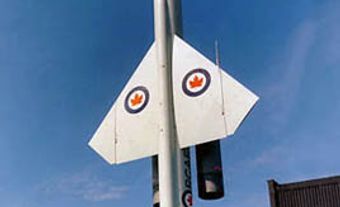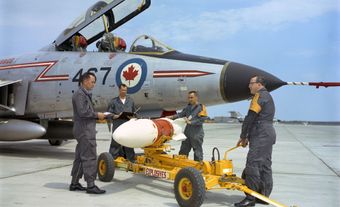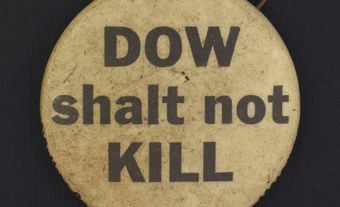Since the 19th century, world powers have discussed arms control and disarmament — that is, reducing, limiting or abolishing certain weapons. They believe that to avoid war, weapons should be reduced in number or eliminated. Countries have sought to ban particularly destructive and inhumane weapons. These include weapons of mass destruction, like chemical, biological and nuclear weapons. (See Canada and Gas Warfare; Canada and Nuclear Weapons.) Conventional arms, like anti-personnel land mines or cluster munitions, have also been controlled. Canada notably led talks on banning the use of land mines. (See Ottawa Treaty.) Canada is a signatory of multiple other arms control treaties, like the Nuclear Non-Proliferation Treaty, the Biological and Toxin Weapons Convention, and the Chemical Weapons Convention.

Hague Peace Conferences
Disarmament and arms control were important topics of discussion at two international peace conferences held in 1899 and 1907 at The Hague in the Netherlands. At the first conference, the Russian minister of foreign affairs proposed limits on the expansion of armed forces and new armaments. Although the delegates wouldn’t agree to limit armaments, they did agree to ban the use of asphyxiating gases and expanding bullets, as well as the releasing of projectiles or explosives from balloons. A third conference, scheduled for 1915, didn’t meet due to the outbreak of the First World War.
Chemical and Biological Weapons
During the First World War, many countries used chemical weapons. Poison gas (e.g., chlorine, phosgene, mustard) caused serious injuries, both temporary and permanent. (See Canada and Gas Warfare.) After the war, countries agreed to ban the use of chemical weapons. The Geneva Protocol (1925) banned the wartime use of chemical and biological weapons. However, it did not forbid countries from developing and making more of these weapons. Over time, Canada, alongside 145 other countries, has signed and ratified this protocol.
In 1972, Canada signed on to the Biological and Toxin Weapons Convention (BTWC). The BTWC further prohibited countries from developing and producing biological weapons. Signatories were also forbidden from acquiring such weapons. Canada is also a party to the Chemical Weapons Convention, which entered into force in 1997. Under the CWC, countries are not allowed to produce or use chemical weapons. They also cannot store or transfer such weapons.
Nuclear Weapons
The Allies developed the first nuclear weapons during the Second World War. In 1945, the United States dropped nuclear bombs on Hiroshima and Nagasaki, Japan. Both cities were devastated and many civilians died. In the wake of the destruction, political and scientific leaders began to prioritize disarmament.
Nuclear Arms Control and Disarmament during the Cold War
During the Cold War, the US and USSR (and their allies) continued to develop and stockpile nuclear weapons technology. By the time of the Cuban Missile Crisis in 1962, both countries could launch nuclear attacks using bombers, intercontinental ballistic missiles and submarines. The threat of mutual destruction using nuclear weapons served as a deterrent to war.
Negotiations to prevent nuclear war began as early as 1946. In 1959, Nikita Khrushchev proposed in the UN General Assembly that nations should commit themselves to complete disarmament. Although this was not achieved by several UN disarmament committees, some measure of "arms control" was reached. These include the 1963 partial ban on testing nuclear weapons and the 1968 Non-Proliferation Treaty (NPT). Canada signed the NPT and remains committed to preventing the spread of nuclear weapons worldwide. Meanwhile, the race to build intercontinental missiles continued. In 1969, the US and USSR decided to hold strategic arms limitation talks by themselves. A treaty, SALT I, came into force in 1972. A second, SALT II, was not ratified by the US Senate, but the two countries nonetheless respected the treaty’s terms.
In 1972, the USSR and the US ratified the Anti-Ballistic Missile (ABM) Treaty. This agreement limited the number of missiles that could intercept nuclear missiles. As only a small fraction of each country’s territory could be defended, the threat of mutual destruction remained, deterring each side from initiating war.
As Canada helped produce the atomic bomb (see Canada and the Manhattan Project), it has participated in many disarmament talks. Canada advocated for mutually balanced, verifiable disarmament. But Canada's freedom of expression has been limited by the need for solidarity within North Atlantic Treaty Organization. The government's concerns were shared by an increasing number of Canadians in the 1980s. They included fears of global destruction, and the strategic implications of a nuclear war between the superpowers (because of Canada's geographical location). Environmental damages were also a consideration. Nuclear testing or war would damage delicate environments such as the Arctic, Great Lakes and coasts. Canada gave up its nuclear weapons between 1968 and 1984. (See Canada and Nuclear Weapons.)
International conferences on arms control continued into the 1980s. US president Ronald Reagan and Soviet leader Mikhail Gorbachev engaged in negotiations. The Intermediate-Range Nuclear Forces Treaty was signed on 8 December 1987. It called for the eventual ban of intermediate-range missiles as well as shorter-range ones. The treaty was the first agreement to eliminate an entire class of nuclear weapons. The 1980s also saw the beginning of the Strategic Arms Reduction Talks (START). START I was signed in 1991 and came into effect in 1994 after some delays caused by the dissolution of the Soviet Union. The treaty limited the number of nuclear weapons and established verification measures, including on-site inspections. These ensured that both countries respected their obligations. Negotiations on START II also began around that time.
In 1996, 44 nations (including Canada) signed the Comprehensive Nuclear-Test-Ban Treaty. It was eventually signed by almost all members of the United Nations. The CTBT bans the use of nuclear explosions, including for testing purposes. As some nations, including the US, signed the treaty but did not ratify it, it has not come into effect.
Nuclear Disarmament in the 21st Century
Nuclear disarmament efforts ran into increased difficulties in the late 1990s and 2000s. START II sought to further reduce the number of Russian and American weapons. However, the treaty fell through as relations worsened and the US pulled out of the ABM Treaty in 2002.
As early as 1997, negotiations began on START III. These talks became the Strategic Offensive Reductions Treaty (SORT), signed in 2002. The number of nuclear weapons was further lowered.
START I was to expire in December 2009. Negotiations on a new treaty to replace it resulted in the New START. Russia and the US signed the agreement in 2010 and it came into effect in February 2011. New START further limited the number of nuclear warheads. Both sides would reduce their arsenal to a maximum of 1,550 deployed strategic warheads. The treaty also limited the number of nuclear deployment systems, like bombers and launchers. New START updated START I’s verification system. In 2021, the US and Russia extended New START’s expiry date by five years.
Arms Control and Disarmament: Conventional Weapons
Countries have also signed agreements to limit or ban conventional weapons that cause severe injuries or indiscriminate harm. For example, 50 states signed the 1980 Convention on Certain Conventional Weapons (also known as the Inhumane Weapons Convention), which regulated and limited weapons such booby traps, mines and incendiary weapons. In 1995, an additional protocol was added which restricted blinding laser weapons. Nations have also signed agreements to ban weapons like anti-personnel mines and cluster munitions, which are, according to the United Nations, “inherently indiscriminate and cause unacceptable humanitarian harm.”
Ottawa Treaty
In the 1990s, Canada led efforts to ban the use of anti-personnel land mines. Mines left in war zones often killed innocent civilians. Non-governmental organizations pressed for an international land mine ban. Canada’s foreign minister, Lloyd Axworthy, encouraged countries to commit to a ban. These efforts ultimately led to the Ottawa Treaty, which 122 countries signed in 1997. Also known as the Ottawa Convention, the agreement banned the production, use and transfer of mines. Countries also committed to destroying the mines they had in inventory. They also had to clear mined areas.
Convention on Cluster Munitions
In 2008, Canada signed the Convention on Cluster Munitions. These munitions come in the form of missiles or artillery shells. They unleash smaller explosives (submunitions) that cause random damage to a large area. Cluster munitions injure and kill soldiers or civilians indiscriminately. Unexploded submunitions that land on the ground also act as land mines.

 Share on Facebook
Share on Facebook Share on X
Share on X Share by Email
Share by Email Share on Google Classroom
Share on Google Classroom


